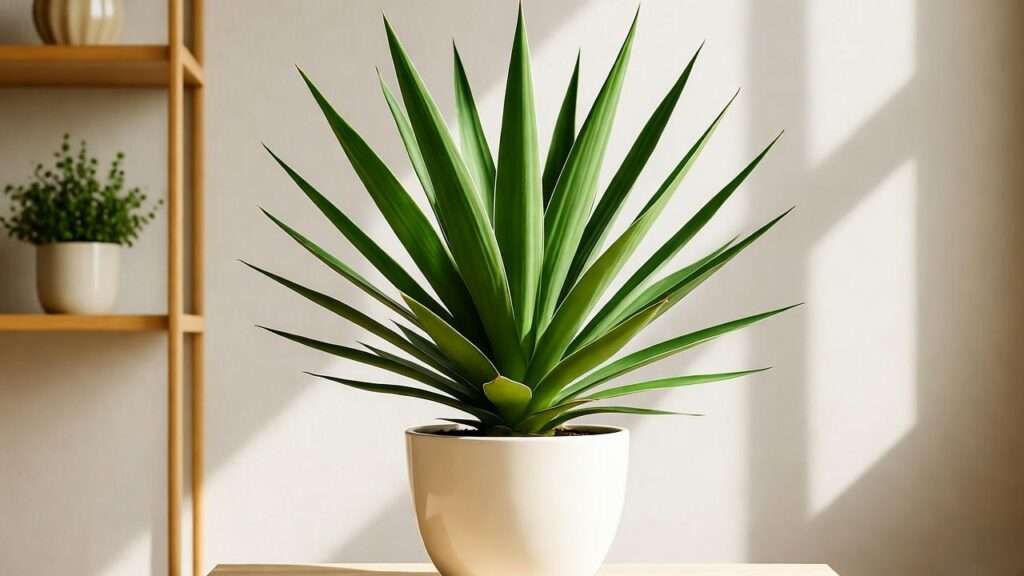Imagine a plant so striking it transforms your space into a desert-chic oasis, yet so low-maintenance it thrives with minimal fuss. Meet the yucca plant! Whether you’re a beginner or a seasoned plant parent, mastering yucca plant care can elevate your home or garden with ease. Many struggle with yellowing leaves, overwatering mishaps, or stunted growth, but with the right knowledge, these issues are easily avoidable. In this comprehensive guide, I’ll share seven expert tips—backed by horticultural insights and my own experience growing yuccas for over a decade—to help your yucca flourish indoors or outdoors. From watering secrets to pest control, this article is your roadmap to a thriving yucca. Let’s dive in! 🌞
1. Understanding Your Yucca Plant 🌵
What is a Yucca Plant?
Yuccas are bold, evergreen perennials known for their sword-shaped leaves and architectural appeal. Belonging to the Asparagaceae family, they include over 40 species, such as Yucca filamentosa (Adam’s needle), Yucca gloriosa (Spanish dagger), and Yucca elephantipes (spineless yucca). These plants are native to arid regions of the Americas, making them naturally drought-tolerant and hardy. Their rosette-shaped foliage and occasional flower spikes add drama to any setting, whether as a houseplant or a garden focal point.
Benefits of Growing Yucca Plants
Yuccas are a dream for busy plant lovers. Their low-maintenance nature means they thrive with minimal care, perfect for those new to plant care or with hectic schedules. Indoors, yuccas can improve air quality by filtering pollutants, as noted in studies by the American Horticultural Society. Outdoors, they shine in xeriscaped gardens, requiring little water and adding a sculptural element to landscapes. Plus, their modern aesthetic pairs beautifully with minimalist or bohemian decor.
Expert Insight: According to the Royal Horticultural Society, yuccas are “resilient survivors,” capable of thriving in harsh conditions where other plants falter, making them a sustainable choice for eco-conscious gardeners. 🌍
2. Ideal Growing Conditions for Yucca Plants ☀️
Light Requirements
Yuccas love light! For indoor yuccas, place them near a south- or west-facing window to ensure bright, indirect light. Outdoor yuccas thrive in full sun, soaking up at least 6 hours of direct sunlight daily. Too little light can cause leggy growth or faded leaves, while excessive direct sun indoors may scorch delicate foliage. Adjust placement seasonally—move indoor yuccas closer to windows in winter to compensate for shorter days.
Temperature and Humidity
Yuccas prefer temperatures between 65–85°F (18–29°C), though they can tolerate brief dips to 50°F (10°C) or spikes to 90°F (32°C). Their desert origins make them well-suited to low-humidity environments, so no need for misting or humidifiers indoors. For outdoor yuccas, protect them from frost by covering them or moving potted plants indoors during cold snaps in USDA zones below 5.
Soil Preferences
Well-draining soil is non-negotiable for yucca plant care. Opt for a cactus or succulent potting mix, or create your own by combining 50% potting soil, 30% sand, and 20% perlite or pumice. Aim for a slightly acidic to neutral pH (6.0–7.0). For outdoor yuccas, ensure the planting site has sandy or loamy soil to prevent waterlogging.
Pro Tip: Here’s a quick checklist for ideal yucca conditions:
- ☑ Bright, indirect light (indoors) or full sun (outdoors)
- ☑ 65–85°F temperature range
- ☑ Well-draining, sandy soil mix
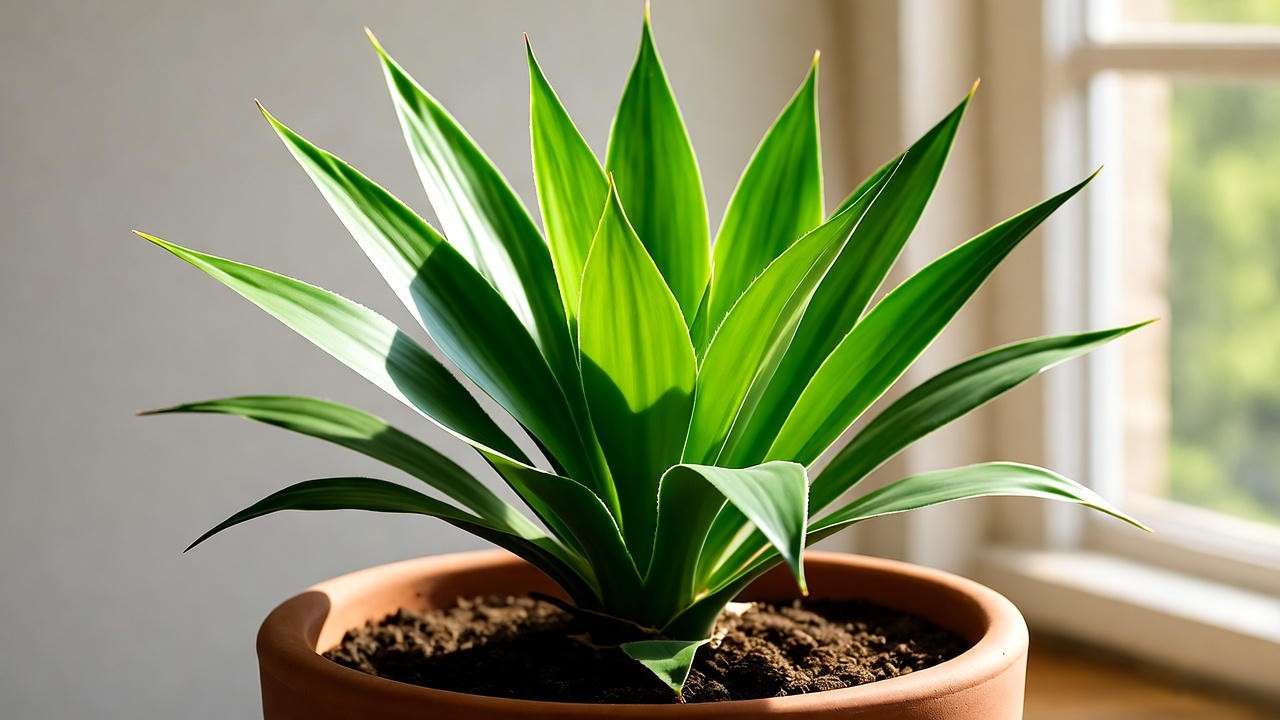
3. Watering Your Yucca Plant Properly 💧
How Often to Water Yuccas
Overwatering is the number one killer of yuccas. As desert natives, they store water in their thick roots, so they need infrequent but deep watering. For indoor yuccas, water every 2–3 weeks, allowing the top 2–3 inches of soil to dry out completely. Outdoor yuccas may need watering every 1–2 weeks in summer, depending on rainfall, but far less in cooler months. Always check soil moisture with your finger or a moisture meter before watering.
Signs of Overwatering and Underwatering
Overwatering leads to yellowing leaves, mushy stems, or root rot—a serious issue that can kill your plant. Underwatering, while less common, causes drooping or browning leaf tips. To fix overwatering, reduce frequency, ensure proper drainage, and consider repotting if root rot is suspected. For underwatered yuccas, gradually increase watering to rehydrate the plant without shocking it.
Case Study: Last year, I rescued a friend’s overwatered Yucca elephantipes by repotting it in fresh, well-draining soil and cutting back watering to once every three weeks. Within two months, new growth appeared, proving that timely intervention can save a struggling yucca! 🌱
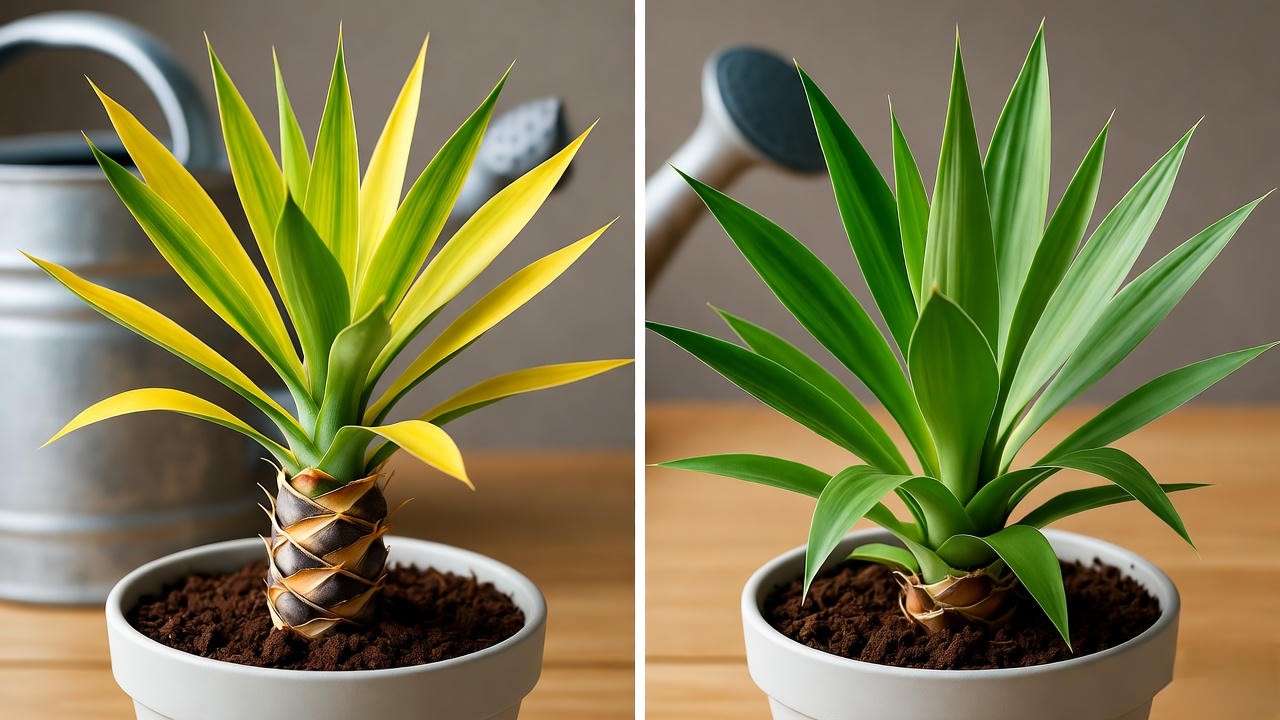
4. Fertilizing and Feeding Your Yucca 🌼
When and How to Fertilize
Yuccas aren’t heavy feeders, but a little fertilizer during the growing season (spring and summer) boosts their vigor. Use a balanced, water-soluble fertilizer (e.g., 10-10-10) or a cactus-specific formula, diluted to half strength. Apply once a month from March to August, avoiding fertilization in fall and winter when the plant is dormant. Always water the plant before fertilizing to prevent root burn.
Organic Alternatives
For eco-conscious gardeners, compost tea or worm castings are excellent organic options. Mix a handful of compost into the topsoil or dilute compost tea to a weak concentration. Over-fertilizing can lead to salt buildup, so flush the soil with water every few months to keep it healthy.
Comparison Table: Synthetic vs. Organic Fertilizers for Yuccas
| Type | Pros | Cons |
|---|---|---|
| Synthetic (10-10-10) | Fast-acting, widely available | Risk of over-fertilization, less eco-friendly |
| Organic (Compost) | Eco-friendly, improves soil health | Slower results, less precise |
Expert Tip: Always dilute fertilizer to avoid burning your yucca’s roots. Less is more with these hardy plants! 🌿
5. Pruning and Maintenance ✂️
Pruning for Health and Aesthetics
Pruning keeps your yucca looking tidy and healthy. Remove dead, yellow, or damaged leaves at the base using clean, sharp shears to prevent infection. For tall varieties like Yucca elephantipes, trim the top to control height or encourage bushier growth. Prune in spring before the growing season for best results. Always wear gloves, as yucca leaves can be sharp!
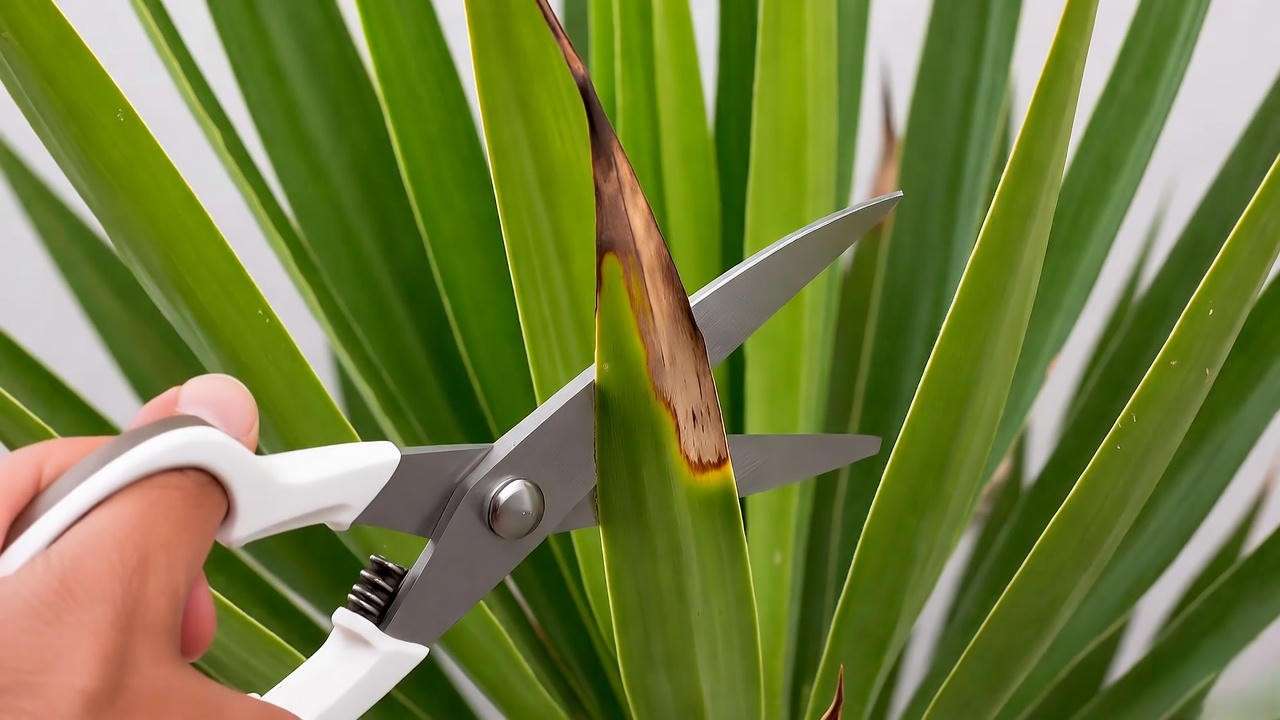
Repotting Indoor Yuccas
Repot every 2–3 years or when the plant becomes root-bound (roots circling the pot or slow growth). Choose a pot 2–3 inches larger in diameter with drainage holes. Gently loosen the root ball, place it in fresh cactus soil, and water sparingly for the first week. Terracotta pots are ideal for their breathability.
Visual Guide Idea: An infographic showing how to prune yucca leaves safely, with steps like:
- Sterilize shears with rubbing alcohol.
- Cut dead leaves at the base.
- Dispose of sharp clippings carefully.
6. Propagating Yucca Plants 🌱
Propagation Methods
Propagating yuccas is a rewarding way to expand your collection or share with friends. The easiest method is using offsets (pups), which are small plants that grow at the base of the parent. In spring, gently separate pups with a sharp knife, ensuring each has roots. Plant in well-draining soil and water sparingly until established. Stem cuttings are another option for spineless yuccas—cut a 4–6-inch section, let it callous for a day, and plant in moist soil.
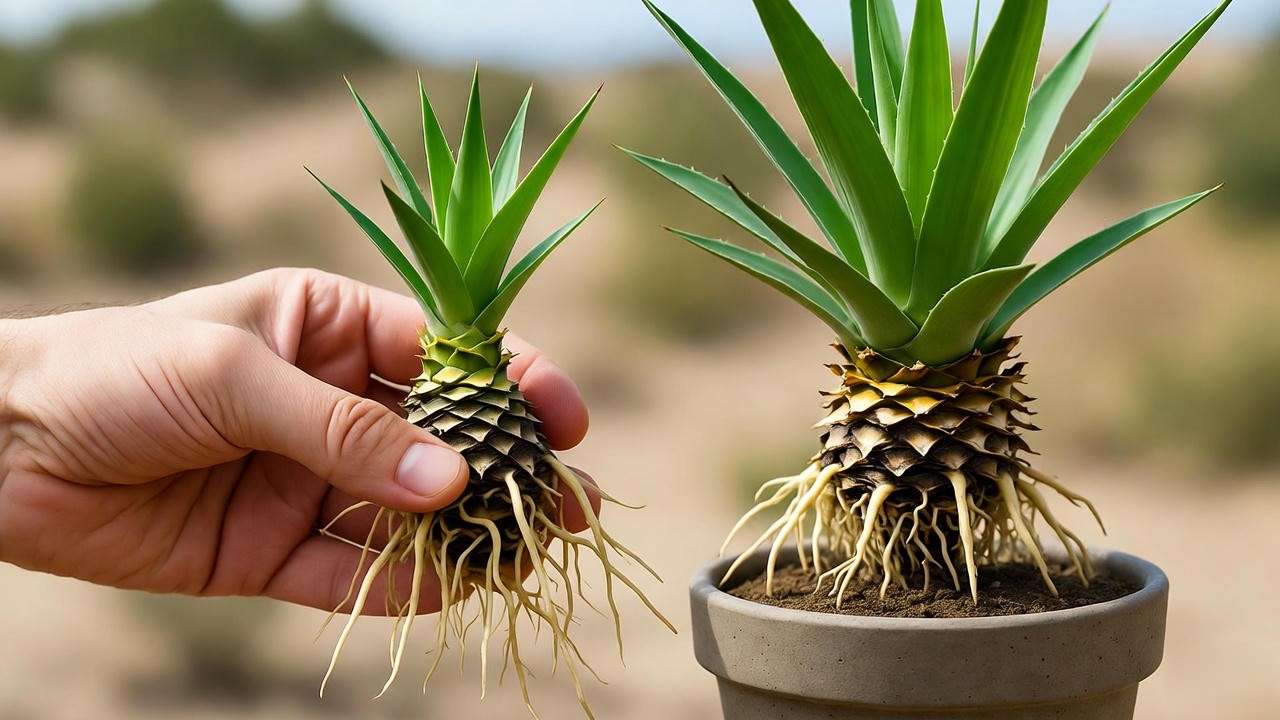
Troubleshooting Propagation Issues
If pups fail to root, check for rot (caused by overwatering) or insufficient light. Ensure the soil stays slightly moist but not soggy, and place cuttings in bright, indirect light. Patience is key—rooting can take 4–6 weeks.
Reader Action: Try propagating a yucca pup and share your success on Instagram with #YuccaCareSuccess! 📸
7. Common Yucca Plant Problems and Solutions 🐛
Nothing is more disheartening than seeing your yucca struggle, but most issues are fixable with the right know-how. In this section, we’ll cover common pests, diseases, and environmental stressors that affect yucca plant care, along with practical solutions to restore your plant’s health.
Pests
Yuccas are relatively pest-resistant, but they can occasionally attract spider mites, scale insects, or mealybugs.
- Spider Mites: Look for fine webbing or speckled leaves. Wipe leaves with a damp cloth and spray with neem oil diluted in water (1 tsp per quart).
- Scale Insects: These appear as small, brown bumps on stems or leaves. Scrape them off gently and apply insecticidal soap weekly until gone.
- Mealybugs: White, cottony masses in leaf axils are a telltale sign. Dab with alcohol-soaked cotton swabs and follow with neem oil.
Prevention Tip: Regularly inspect your yucca and maintain good air circulation to deter pests.
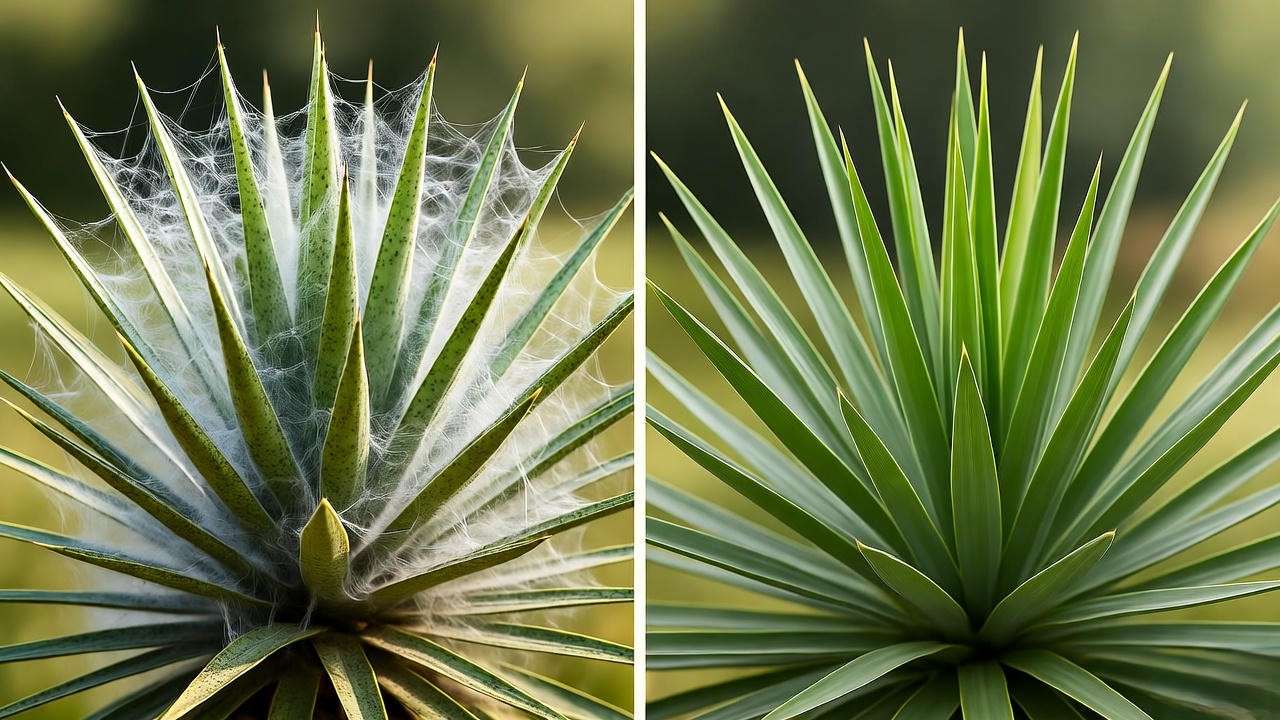
Diseases
Root rot, caused by overwatering, is the most common yucca disease. Symptoms include soft, blackened roots and wilting foliage. To treat:
- Remove the plant from its pot or soil.
- Trim away affected roots with sterilized shears.
- Repot in fresh, well-draining soil and reduce watering frequency.
Fungal leaf spots, though rare, can occur in humid conditions. Improve air circulation and avoid overhead watering for outdoor yuccas. If needed, apply a copper-based fungicide as directed.
Environmental Stress
Yuccas can suffer from environmental issues like:
- Leaf Drop: Often caused by sudden temperature changes or drafts. Move indoor yuccas away from air vents or cold windows.
- Browning Tips: Indicates underwatering or low humidity. Check soil moisture and increase watering slightly if dry.
- Wilting: Can result from overwatering or poor drainage. Adjust watering habits and ensure the pot or soil drains well.
Expert Insight: The University of Arizona’s Cooperative Extension notes that most yucca issues stem from improper watering or drainage, emphasizing the importance of mimicking their desert habitat for optimal health. 🌵
8. Indoor vs. Outdoor Yucca Care: Key Differences 🌳
Yuccas are versatile, thriving both indoors and outdoors, but their care needs differ slightly. Understanding these distinctions ensures your yucca plant care routine is tailored for success.
Indoor Yucca Care
Indoor yuccas, like Yucca elephantipes, need bright, indirect light to mimic their sunny native environment. Place them near south- or west-facing windows, rotating the pot monthly for even growth. Maintain indoor temperatures between 65–85°F and avoid placing near heating vents or cold drafts. Low humidity is fine, but dust leaves monthly to keep them photosynthesizing efficiently. Styling tip: Pair your yucca with a sleek ceramic pot for a modern look that complements minimalist or bohemian decor.
Outdoor Yucca Care
Outdoor yuccas, such as Yucca filamentosa or Yucca gloriosa, thrive in USDA hardiness zones 5–10. Plant in full sun with well-draining soil to prevent root rot. They’re ideal for xeriscaping, pairing beautifully with succulents or ornamental grasses in water-wise gardens. In colder climates (zones 5–6), mulch the base in winter or cover with burlap to protect from frost. For a stunning landscape, use yuccas as focal points or border plants to add height and texture.
Comparison Chart: Indoor vs. Outdoor Yucca Care
| Aspect | Indoor Yucca | Outdoor Yucca |
|---|---|---|
| Light | Bright, indirect light | Full sun (6+ hours daily) |
| Watering | Every 2–3 weeks, soil fully dry | Every 1–2 weeks, adjust for rain |
| Winter Care | Protect from drafts | Mulch or cover in cold climates |
| Styling | Decorative pots, indoor focal point | Xeriscaping, garden borders |
Visual Idea: A side-by-side infographic comparing indoor and outdoor yucca care for quick reader reference.
9. Seasonal Yucca Care Tips ❄️🌸
Yuccas respond to seasonal changes, so adjusting your care routine ensures year-round health. Here’s a breakdown by season:
- Spring: The growing season begins! Fertilize monthly, propagate pups, and repot if needed. Check for new growth and prune dead leaves.
- Summer: Monitor for pests like spider mites, especially in hot, dry conditions. Water slightly more frequently for outdoor yuccas, ensuring soil dries out between sessions.
- Fall: Reduce watering as growth slows. For outdoor yuccas, prepare for winter by mulching the base in colder zones.
- Winter: Minimize care—water sparingly (every 3–4 weeks for indoor yuccas) and avoid fertilizing. Protect outdoor yuccas from frost with covers or by moving potted plants indoors.
Pro Tip: Create a seasonal care calendar:
- March–May: Fertilize, propagate, repot.
- June–August: Pest checks, moderate watering.
- September–November: Reduce watering, mulch outdoor plants.
- December–February: Minimal watering, frost protection.
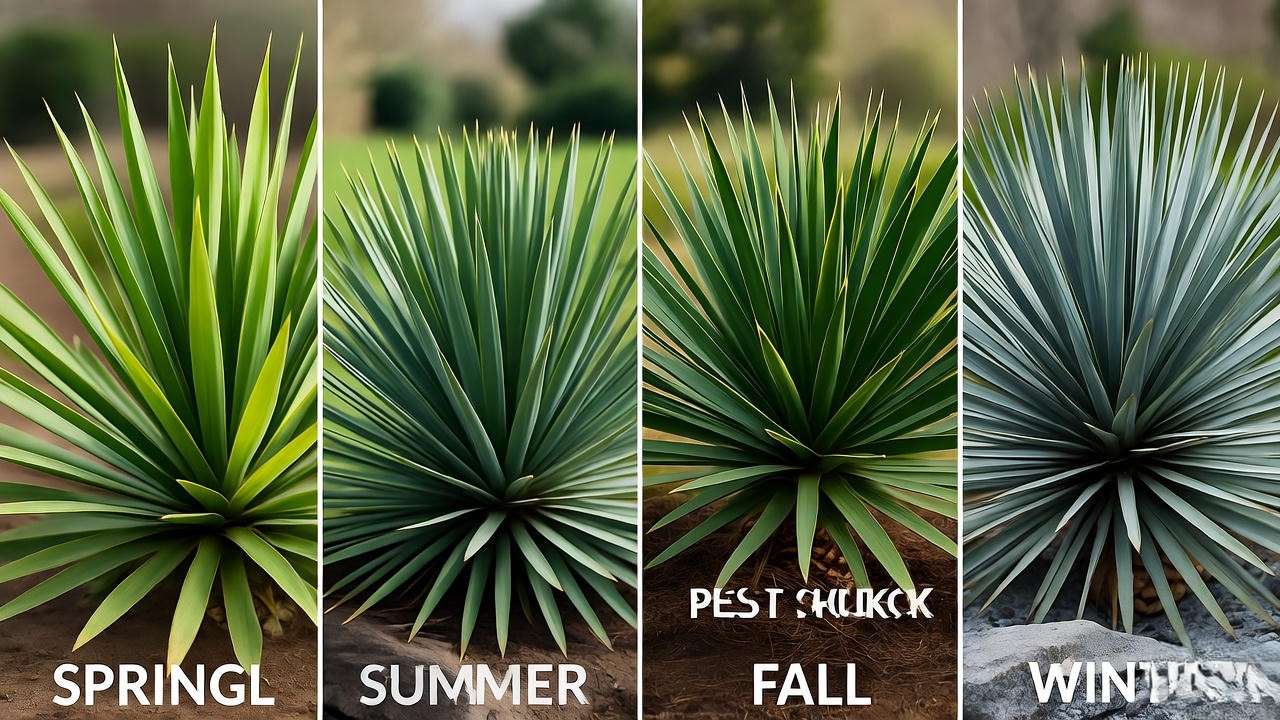
10. FAQs About Yucca Plant Care ❓
Here are answers to common questions to help you master yucca plant care:
Why is my yucca plant turning yellow?
Yellowing leaves often indicate overwatering or poor drainage. Check the soil—if it’s soggy, let it dry out completely and adjust your watering schedule. Repot if root rot is suspected.
Can yucca plants survive in low light?
Yuccas prefer bright light but can tolerate moderate light for short periods. In low light, growth may slow, and leaves may fade. Move to a brighter spot if possible.
How do I know if my yucca is overwatered?
Signs include yellow, mushy leaves or a soft stem. Test soil moisture and reduce watering frequency. Ensure the pot has drainage holes.
Are yucca plants toxic to pets?
Yes, yuccas are toxic to cats and dogs if ingested, causing vomiting or diarrhea. Keep them out of reach or opt for pet-safe plants if concerned.
How fast do yucca plants grow?
Yuccas grow slowly, adding 6–12 inches per year under ideal conditions. Indoor yuccas may grow slower due to limited light.
Conclusion 🌟
Mastering yucca plant care is easier than you think! By following these seven expert tips—providing proper light, watering sparingly, fertilizing wisely, pruning thoughtfully, propagating carefully, troubleshooting issues, and adjusting for indoor or outdoor settings—you’ll keep your yucca thriving for years. Whether it’s a statement piece in your living room or a bold addition to your garden, a healthy yucca brings beauty and resilience to any space. Start implementing these tips today, and share your yucca journey in the comments or on social media with #YuccaCareSuccess! Explore our other plant care guides for more tips to grow your green oasis. 🌿

